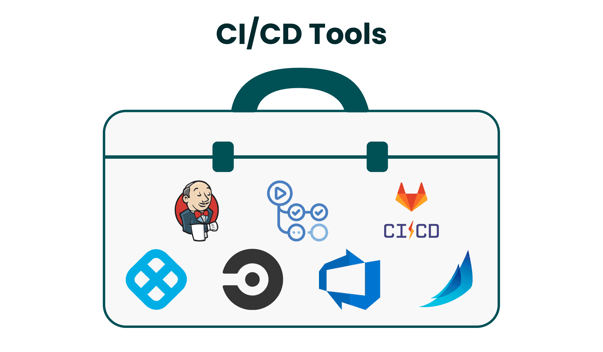In This Series: Everything DevOps Consulting Has Taught Me
- CI/CD Tools & Processes: Everything DevOps Consulting Has Taught Me
- CI/CD Pipelines & Use Cases: Everything DevOps Consulting Has Taught Me
Continuous Integration (CI) and Continuous Delivery & Deployment (CD) are pivotal concepts in modern software development, facilitating rapid and reliable delivery. By frequently integrating code into a shared repository, detecting issues early, and automating deployments, CI/CD ensures that software can consistently be released to production with high confidence.
Why CI/CD Matters: Beyond Technology
In straightforward terms, CI/CD is essential to eliminate repetitive tasks from our development flow, to accelerate the timeline from code commit to deployment, and to align best practices with the path of least resistance—making the right way also the easiest way.
Throughout my DevOps consulting career, I've realized that our work transcends the allure of 'cool' technology. While the tech is a perk, the true purpose of our work is far more profound.
We do this work because it makes people’s lives better. We shift tedious, repetitive tasks from human to machine, not just for efficiency, but to free human creativity and intellect. This shift allows individuals to focus on what they do best: innovating and solving complex challenges.
Moreover, the advantages of adopting a DevOps mindset extend well beyond the realm of developers. Every stakeholder in the project lifecycle—including managers, test engineers, infrastructure administrators, and especially the customers—reaps the rewards of accelerated delivery, enhanced reliability, and a more consistent software development process.
This blog series distills years of hands-on experience into essential insights and lessons about CI/CD pipelines. I will delve into the challenges I've faced and the solutions I've crafted, aiming to simplify the learning curve for others in the DevOps field. Through these articles, I aspire to help you not only enhance your development pipelines but fundamentally transform the nature of your work.
Exploring the Core CI/CD Processes
CI/CD pipelines, while varying in complexity, fundamentally follow a series of steps: Build, Test, Package, Archive, and Deploy. Each step is executed sequentially, typically triggered by a version control operation, such as a git push, which makes these pipelines both responsive and efficient. If any step fails, the pipeline halts to prevent the propagation of errors.
Let’s break down the critical stages that ensure every commit you make moves from development to deployment as smoothly as possible.

Build
The journey begins with the build process. Here, your source code, along with any dependencies, is compiled to create an executable application. The build stage is essential for catching syntax errors and other "compile-time" issues before they can impact production.
Test
After building, automated tests are run against your application. Your automated tests might include unit tests, integration tests, and sometimes security tests. The test stage is crucial for catching bugs early, significantly reducing the cost and effort required to fix them later.
Package
Once your application passes all tests, it's time to package it into a deployable artifact. Your artifact could be a binary, a Docker container, or any other format that fits your target deployment environment.
Archive
Successful builds are then archived for record-keeping and rollback purposes. Archiving your builds ensures that any version of the application can be restored and redeployed if necessary.
Deploy
The final stage is deployment. This step automates the deployment of your application to a production or staging environment. With the right automation in place, deployment can happen with minimal human intervention, allowing for faster releases and reducing the chance of human error.
The Role of Tools in CI/CD
CI/CD tools make up the backbone that supports the entire pipeline. You might already be familiar with Jenkins, one of the most popular tools, but there are a plethora of other CI/CD tools to explore.

Jenkins
A stalwart in the CI/CD landscape, Jenkins automates the phases of build, test, and deployment processes. Its strength lies in its broad adaptability through plugins, enabling integration with virtually all development, testing, and deployment tools. Whether you are automating a basic three-step process or a complex pipeline with sophisticated requirements, Jenkins can be tailored to meet your needs.
GitHub Actions
For projects hosted on GitHub, GitHub Actions offers a powerful, integrated way to automate workflows directly from your repository. You can set up workflows to build, test, and deploy your code based on any event in GitHub, such as pushing commits or creating pull requests.
GitLab CI/CD
Integrated directly into the GitLab platform, this tool provides a straightforward setup for CI/CD pipelines which are defined in a .gitlab-ci.yml file within your repository. This makes it especially appealing for GitLab users, providing a native, coherent experience across the software development lifecycle.
Azure DevOps
From Microsoft, Azure DevOps provides a suite of tools that cover the entire development life cycle, which includes CI/CD via Azure Pipelines. It supports various languages and frameworks and integrates well with Azure's cloud services, making it ideal for teams using Microsoft products extensively.
Other Tools
Many other tools in the market offer unique features for deployment automation, scaling, and management of complex pipelines across clouds. Lesser-known tools like Spinnaker, Harness, and CircleCI might be the best CI/CD tools for your pipeline. It's all about knowing what you need and making an informed decision.
Conclusion
The future of development is undoubtedly leaning towards more integrated and automated ecosystems. As you continue to navigate the complexities of CI/CD, keep in mind that the journey is one of continuous learning and adaptation. Embrace these tools and practices not just as necessities, but as opportunities to redefine the scope and impact of your work.
In the coming entries of this series, we will delve deeper into specific challenges, advanced configurations, and success stories from the field, aiming to provide you with practical insights and actionable strategies to maximize your CI/CD efforts.
Thank you for joining me on this journey. Here’s to building better, faster, and smarter—not just today, but every day.




